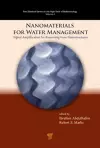
Nanomaterials for Water Management
2 contributors - Hardback
£115.00
Ibrahim Abdulhalim is a professor in the Department of Electrooptic Engineering at Ben Gurion University. He has worked in research and development in a variety of academic institutions and industrial companies. From August 1988 till May 1991, he was a research associate within the Optoelectronic Computing Systems Center in the University of Colorado at Boulder, USA where he worked on ferroelectric liquid crystal spatial light modulators. During July 1991 till July 1993 he was a research fellow in the Optoelectronics Research Center of Southampton University, England, working on fiber acousto-optic modulators for Q-switching and Mode-locking of fiber lasers. During 2000-2001 he was with the Thin Films Center of the University of Western Scotland as a researcher and lecturer. Among the companies he worked for are KLA-Tencor and Nova measuring instruments working in optical metrology systems for the inspection of the fabrication processes in the microelectronics industry and in GWS-Photonics working on guided wave liquid crystal devices for the optical telecommunications. Since October 2005 he joined the Department of Electrooptic Engineering at Ben Gurion University. His current research activities involve liquid crystal devices, nanophotonic and plasmonic structures for biosensing, improved biomedical optical imaging techniques such as spectropolarimetric imaging and full field optical coherence tomography using liquid crystal devices. Prof. Abdulhalim has published over 120 journal articles, 60 conference proceedings papers, 10 book chapters, coauthored 1 book titled Integrated Nanophotonic Devices (Micro and Nano Technologies), and has 10 patents. He became a fellow of the Institute of Physics, UK in 2004 and SPIE fellow in 2010. He is an associate editor of the SPIE Journal of NanoPhotonics and for the Journal of Physics Express. Prof. Abdulhalim is acting as the head of Department of Electrooptic Engineering since 2007.
Robert S. Marks is a professor at the Department of Biotechnology Engineering, at the Ben Gurion University of the Negev. His PhD was at the Weizmann Institute, Israel and postdoctorate at the University of Cambridge, England. He has established in 1995 a biosensors laboratory at the Ben Gurion University, Israel, resulting in over 100 publications, 20 chapters, and 4 granted patents. His work consists in the development of fiber-optic probes, including both novel interfacial functionalization chemistries as well as transducer configuration, including, fiber-optic immunosensors (Ebola, Dengue, West Nile, Rift Valley fever viruses, Hepatitis C, Brucella and cholera toxin), and fiber-optic bioreporter biosensors (both for on-site testing or flow-through devices) for water monitoring (genotoxicity, cytotoxicity, heavy metals, endocrine disrupting compounds). Other projects consist in developing a chemiluminescent bioreporter nanotoxicity system, development of a reverse genetics cell reporter assay to influenza, and bioreporter panel fingerprints for the discovery of bioactive agents (antibiotics, quorum sensor inhibitors from marine microorganisms). Nanobiotechnology, including nanolithography, metal enhanced fluorescence or bioluminescence, nanoantennas, tailored nanomaterials including conductive or affinity hydrogels. He has chaired 16 international conferences, has given 64 invited and 45 contributed lectures at conferences, 160 posters presentation with colleagues and students, and 79 academic lectures around the world. He is affiliated to the National Institute for Biotechnology in the Negev and the Ilse Katz Center for Meso and Nano-scale Science and Technology, and is an adjunct professor at the University of Maryland (UMBC) and at the Nanyang Technological University (MSE) where he heads the Water thrust of the NRF CREATE center Nanomaterials for Energy and Water Management, He was the editor-in-chief for the Wiley 2 Handbooks on Biosensors and Biochips and is presently the founding editor of the Pan Stanford series of the High Tech of Biotechnology.